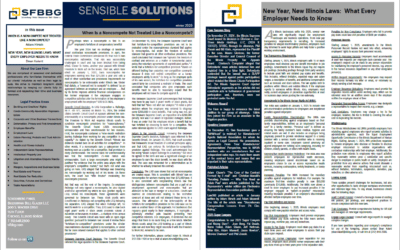This is the second of two articles on the effect that California law can have on businesses throughout the country and even abroad. Last month’s article delved into California’s recently enacted “AB5” statute which provides an “ABC” test to determine if a worker/service provider is an independent contractor or an employee. AB5 was enacted in response to the new “gig” economy in which businesses seek to utilize independent contractors, as opposed to direct employees, to sell their services and products in an effort to avoid employment-related benefits and legal obligations. The scope of that statute, of course, is important to any business that either is or uses an independent sales representative or sub-representative in California. Moreover, AB5 is being viewed as a model for similar legislation in other states.
The focus of this month’s article is California’s “Proposition 65” (“Prop 65”), which has had a significant and costly impact on all businesses whose products are sold to consumers in California. Unlike AB5, which only become effective this year, Prop 65 dates back to 1986, with some recent revisions that have been a boon to label and sign makers, as well as to California attorneys who seek to trap the unwary who unknowingly violate Prop 65.
Prop 65 — The Basics
As succinctly stated by the California Office of Environmental Health Hazard Assessment (“OEHHA”), Prop 65, which is formally known as the “California Safe Drinking and Toxic Enforcement Act of 1986,” “…requires businesses to provide warnings to Californians about significant exposures to chemicals that cause cancer, birth defects or other reproductive harm.” To achieve that admirable goal, Prop 65 requires that businesses provide a “clear and reasonable” warning before knowingly and intentionally selling products to consumers in California that contain one or more of approximately 900 chemicals found in a list compiled by the State of California, that are known to cause cancer, birth defects or other reproductive harm. Such clear and reasonable warnings can be given in various ways, such as by putting labels on the products themselves or on the direct containers in which the products are packaged, or by posting signs and notices at the workplace or on shelves or counters where consumers will see them, as well as on printed promotional materials, catalogues and on related websites.
The requirements of Prop 65 cover products sold in California regardless of the place of manufacture. It applies both to consumer products and products that can cause environmental exposure to one or more of the 900 listed chemicals through breathing, drinking or ingesting. In short, the scope and resulting impact of Prop 65 is quite broad. However, businesses with fewer than 10 employees are exempt, as are products whose use of a listed chemical is below the dictated threshold level.
Now, those of you not in California may be wondering why you need be concerned about California law. Well, you need to know that the reach of Prop 65 is national in scope. Companies who manufacture, distribute or sell products in California that are not compliant with the dictates of Prop 65 can be on the receiving end of a claim or lawsuit that seeks to recover up to $2500 a day, plus attorneys’ fees. It doesn’t matter that your company may be thousands of miles from sunny California. Further, although commission-only sales representatives, as opposed to “buy/sell” or warehousing representatives, likely have minimal exposure because they do not take possession of their principals’ products, they nonetheless need to be aware of the scope and impact of Prop 65. They could still be made a party to a claim or in litigation relating to products for which they have solicited sales that are not compliant with Prop 65. To avoid that possibility, it is imperative that you know about and comply with Prop 65. The easiest way to do so, is to make sure that the products you manufacture or handle in the supply chain, provide the requisite “clear and reasonable” warnings. Although companies are free to develop their own warnings, most use the “safe harbor” language provided by Prop 65, which if used properly will protect you from claims.
Safe Harbor Warnings
One way to comply with Prop 65 is through the use of labels that are affixed to products or to their immediate packaging. What constitutes a clear and reasonable warning had been an issue until Prop 65 was revised in August 2018 to include new “safe harbor” warning language and procedures. To comply with Prop 65’s safe harbor, warnings must include all of the following:
- The use of the symbol (pictured right).hazard symbol.
- The name of at least one listed chemical.
- The word “WARNING” in all upper-case and bold letters.
- The URL for the California official Prop 65 website — www.P65Warnings.ca.gov
In addition, safe harbor warnings must use the phrase “Can expose you to chemicals that cause harm.” Examples of such warnings are as follows:
- ⚠ WARNING: This product can expose you to chemicals, including [name of listed chemical], which is [are] known to the State of California to cause cancer. For more information, go to www.P65Warnings.ca.gov.”
- ⚠ WARNING: This product can expose you to chemicals, including [name of listed chemical], which is known to the State of California to cause cancer, [name another listed chemical] which is known to the State of California to cause birth defects or other reproductive harm. For more information, go to www.P65Warnings.ca.gov.”
In addition to the above “long form” warnings, Prop 65 also allows for the use in certain circumstances of abbreviated warnings — one for carcinogens, one for reproductive toxicants, and one for products with both carcinogens and reproductive toxicants. These abbreviated warnings can be utilized when the warnings are affixed to the products themselves or on websites. These abbreviated warnings are as follows:
- ⚠ WARNING: Cancer — www.P65Warnings.ca.gov.
- ⚠ WARNING: Reproductive Harm — www.P65Warnings.ca.gov.
- ⚠ WARNING: Cancer and Reproductive Harm — www.P65Warnings.ca.gov.
The use of the symbol ⚠ does not need to be in color unless there is color on the label. Further the triangle symbol must be no smaller than the word “WARNING,” which, in turn, must be no smaller than the larger type size used for other consumer information on the product. In no event can the print on a product warning be less than six‑point type.
Another way to comply with Prop 65, other than by putting labels on products and their packaging, is by passing the responsibility down the supply chain, to distributors and to retailers, if applicable, through the use of written notices. Such notices must state that a product requires a warning and that it specifically identify the product, such as by its UPC. The notice also must be accompanied by warning materials — labels, signs or shelf tags — that will be used to provide consumers with the requisite clear and reasonable warning. In addition, such written notices need to be renewed annually or whenever a different or additional chemical is used in the product.
Prop 65: A Trap for the Unaware
Anyone who doubts the national effect of Prop 65, need only visit a local hardware store or other retailer to find that many, if not most, products now include Prop 65 warnings. Or, visit a wholesale distributor and find a plethora of warning signs and shelf tags prominently displayed. It doesn’t matter if you are in the Midwest, East Coast or in the South, you will find Prop 65 warnings. This is not by happenstance because if any of those products should find their way to a consumer in California without the requisite Prop 65 warnings, the manufacturer of that product and others in the supply chain could find themselves on the receiving end of a notice of violation sent by an attorney on behalf of a “consumer” in California. You see, Prop 65 includes what is called a private right of action that allows consumers, through their own private attorney, to seek damages for such violations. Violations of Prop 65 can result in a penalty of up to $2500 per day for each violation. A complaining consumer can receive 25 percent of any amount collected (with the balance going to the State of California, together with attorneys’ fees and costs. Thus if a manufacturer, distributor or a “buy/sell” or warehousing sales representative sells a product without the requisite Prop 65 warning to a consumer in California, even if done indirectly through the website of another company in the supply chain, it could be confronted with a claim for thousands of dollars of statutory damages. This gives consumers in California and their attorneys, quite an incentive to be on the lookout for violators.
In fact, there is now a cottage industry of California attorneys and their clients who actively look to purchase products from companies outside of California who are unaware of Prop 65. There are numerous instances in which companies located thousands of miles from California have been caught in the web of Prop 65 claims. In one instance, the offending products were sold to a local distributor which, in turn, listed the product for sale online. The manufacturer and the distributor were both about as far away from California as one can get in the continental U.S.A. However, a “consumer” just happened to purchase online several of the products that had no Prop 65 warning. As a result, the “consumer’s” attorney promptly fired out a notice of violation threatening to file suit. The prospect of being embroiled in costly litigation in California is what drives many recipients of such letters to quickly settle such claims. It is cheaper for the violator to pay $5,000-$10,000 or more to quickly settle a claim than it is to retain its own counsel in California and defend the claim in litigation in which the claimant need not prove any injury from the non-compliant product. It’s best to avoid such situations, which is the point of this article.
So, What to Do?
If you are a manufacturer or distributor, or a “buy/sell” or warehousing sales representative, you need to make sure that the products you sell and/or ship include warnings that are compliant with Prop 65. You need to do so even if the products are not being sold or shipped directly to consumers in or to California. An online sale of a non-compliant product to a consumer in California is enough to put you at risk. In addition, businesses can seek to protect themselves through their contracts with suppliers, wholesale and retail customers, or principals.
Also, as noted previously, although the prospect that a commission-only sales representative will be the subject of a Prop 65 violation claim is limited, that is still a possibility, just as they sometimes are named as defendants in products liability lawsuits involving their principal’s products. For that very reason, we have expanded the indemnification provisions in representative agreements that we prepare to include indemnification for “any claim that the principal’s products fail to comply with any applicable statute, law, rule, regulations, or order.” Of course, such contractual protection is only as good as the company behind it. That is why to avoid the prospect of being an unwary victim of Prop 65, businesses should make sure that the products they sell or handle are compliant with Prop 65. Clearly, when it comes to Prop 65, an ounce of prevention is truly worth more than a pound of cure.
This article, like its predecessor article about AB5, are but brief summaries of some of the key provisions and requirements dictated by these two statutes. They are not intended to replace a more detailed review of the statutes themselves to assure that your business, its products, and the manner in which it operates are in compliance. When in doubt, ask your legal counsel.
[DISCLAIMER – This information is solely for information purposes and does not constitute legal advice. Please contact SFBBG with all legal questions.]
This article was published by Agency Sales, a MANA resource for principals and reps.



